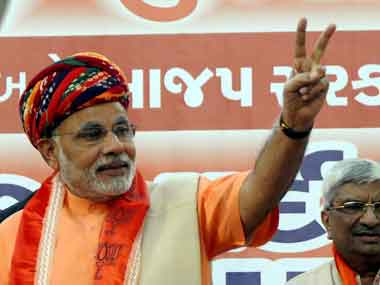For the BJP and its prime ministerial candidate Narendra Modi, the road to power in Delhi passes through Uttar Pradesh. The CNN-IBN –CSDS Election Tracker conducted in the second half of March brings good news of a smooth ride in India’s largest state for the BJP. If polls were held today, the BJP would record its best performance in the state since 1998. According to the opinion poll, the BJP is forecast to corner 36 percent of the vote, retaining its vote share projected in the earlier February Election Tracker. The BJP is projected to win between 42 and 50 of the state’s 80 Lok Sabha seats. In a four way contest (with the SP, BSP and Congress), a vote share above 35 percent is usually enough for a landslide. According to the poll, the BJP’s closest rival, Samajwadi Party will win 22 percent of the vote, the Bahujan Samaj Party 18 percent and the Congress-Rashtriya Lok Dal combine 16 percent. Now that it is clear that there will be no pre-poll alliances between the SP, BSP and Cong-RLD trio (something which was open at the time of the February opinion poll), the advantage clearly lies with the BJP. That the popular Narendra Modi—his popularity seems to exceed than that of his party—has since been declared as a candidate from Varanasi would aid the BJP’s momentum. For a serious shot at forming a stable government at the Centre, Modi would want the party to get as close to 50 seats as possible (if not more). [caption id=“attachment_1464599” align=“alignleft” width=“380”]  Gujarat Chief Minister Narendra Modi. PTI[/caption] Of course, it is nothing new for Uttar Pradesh to be THE battleground state in a General Election. However, in 2004 and 2009, it didn’t quite play a pivotal role as the UPA was powered by Andhra Pradesh and Tamil Nadu (the two states together have 81 Lok Sabha seats). That is set to change with the BJP’s ascendance. Unlike the Congress, it has fewer routes to power at the Centre. That this time, the BJP’s rise in Uttar Pradesh is being led by a man from Gujarat is one of the more remarkable features of a very interesting election. It is also the first time that the BJP is seeking to win the state by presenting a development agenda, eschewing the temple politics which drove it to power in the 1990s. The battle isn’t won for the BJP yet. There may be hurdles. Mayawati’s BSP is usually under-estimated in opinion polls and could put up a stronger fight. However, if the opinion poll is correct, the 18 percentage point vote share gap between BJP and BSP will not be bridged by any margin of error. To mount a serious challenge, the BSP will need to pick up voters from outside its traditional constituencies. Also, in Uttar Pradesh, the Muslim vote is significant in several constituencies. The Congress, led by its president Sonia Gandhi has made an explicit, bordering on communal, appeal for a consolidated Muslim vote to defeat the BJP. The question is whether there will be a consolidation, and around whom. A tainted, under-performing Congress is not a magnet for a voter from any community. And the SP has botched its copybook after two years of inept government in the state. Perhaps then, the only serious challenge to the BJP will arise if Uttar Pradesh’s Muslims consolidate around the BSP, which already has a core base of Dalits. But note that by supporting the UPA studiously over the last 10 years, both the SP and BSP have acquired more than an element of anti-incumbency. On the other hand, this could be the election where voters cast their ballot setting aside narrow identity politics. Interestingly, in a CNN-IBN Open Mike show anchored by Sagarika Ghose on 2 April, a Dalit community in Sarfabad in Uttar Pradesh (just outside Noida) voiced their open support for Modi, making the distinction that while they wanted (the strong, nationalist) Modi at the Centre, they would vote for Mayawati in the state. There is a new, more-sophisticated-than-ever Indian voter waiting to cast his or her vote. Many old assumptions on the politics of Uttar Pradesh may just need to be junked on 16 May, 2014.
It is also the first time that the BJP is seeking to win the state by presenting a development agenda, eschewing the temple politics which drove it to power in the 1990s.
Advertisement
End of Article


)
)
)
)
)
)
)
)
)



